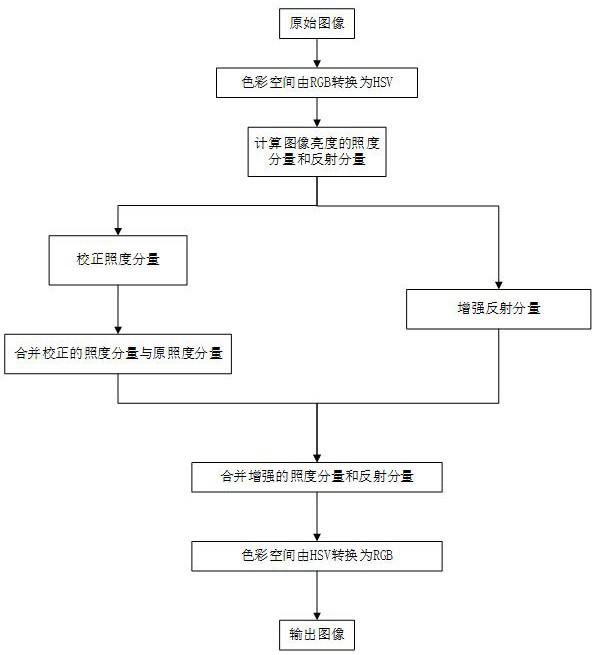Adaptive enhancement method for image with uneven brightness
An adaptive enhancement and image technology, applied in the field of image processing, can solve the problems of regional information loss, over-enhancement, under-enhancement, etc.
- Summary
- Abstract
- Description
- Claims
- Application Information
AI Technical Summary
Problems solved by technology
Method used
Image
Examples
Embodiment 1
[0065] Embodiment 1: an adaptive enhancement method for images with uneven brightness, such as figure 1 As shown, it specifically includes the following steps:
[0066] (1) Convert the original image to The color space is converted from RGB to HSV, and the converted image is obtained ;
[0067] (2) Calculate the image using a multi-scale filtering algorithm color space illuminance component , and then by the illuminance component and component calculated reflection component ;
[0068] (3) Calculated using the OTSU algorithm Segmentation Threshold for Components , by the segmentation threshold Determine illuminance components two of correction factor and , get the illuminance component according to the correction factor The two rectified images of and ;
[0069] (4) Use the illuminance component fusion coefficient to correct the image , and illuminance components Fusion into one image to get enhanced illuminance components ;
[0...
Embodiment 2
[0072] Embodiment 2: an adaptive enhancement method for images with uneven brightness, specifically comprising the following steps:
[0073] (1) Convert the original image to The color space is converted from RGB to HSV, and the converted image is obtained ;
[0074] image of The color space is expressed as ,in The coordinates in the image are The red, green and blue color values of the pixel, the value is a real number between the interval [0,1], the maximum value of the three colors of red, green and blue for each pixel is , with a minimum value of ;
[0075] use and will image The color space is given by converted to , to get the image ,image of The color space is expressed as ,in The coordinates in the image are The hue, saturation, and lightness of a pixel; the conversion formula is as follows:
[0076] ;
[0077] ;
[0078] ;
[0079] In the formula, , .
[0080] (2) Calculate the image using a multi-scale filtering...
PUM
 Login to View More
Login to View More Abstract
Description
Claims
Application Information
 Login to View More
Login to View More - R&D
- Intellectual Property
- Life Sciences
- Materials
- Tech Scout
- Unparalleled Data Quality
- Higher Quality Content
- 60% Fewer Hallucinations
Browse by: Latest US Patents, China's latest patents, Technical Efficacy Thesaurus, Application Domain, Technology Topic, Popular Technical Reports.
© 2025 PatSnap. All rights reserved.Legal|Privacy policy|Modern Slavery Act Transparency Statement|Sitemap|About US| Contact US: help@patsnap.com



